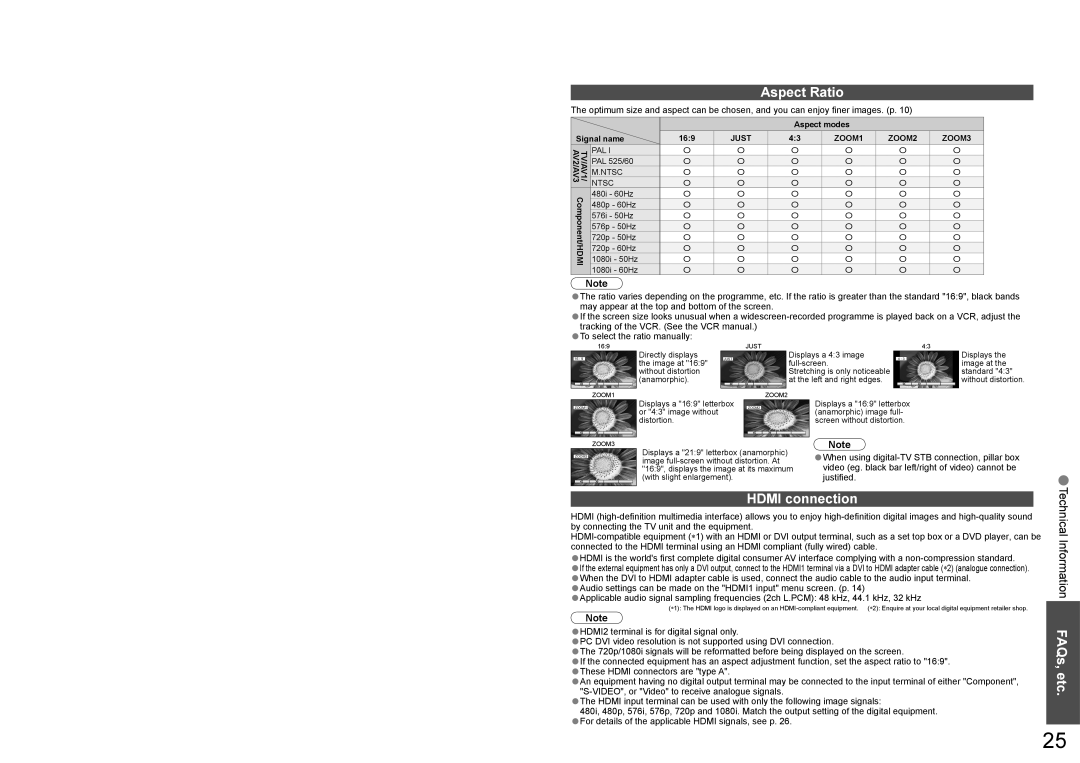
Aspect Ratio
The optimum size and aspect can be chosen, and you can enjoy finer images. (p. 10)
|
|
|
| Aspect modes |
|
| ||
Signal name | 16:9 | JUST | 4:3 | ZOOM1 | ZOOM2 | ZOOM3 | ||
TV/AV1/ AV2/AV3 | PAL I | O | O | O | O | O | O | |
PAL 525/60 | O | O | O | O | O | O | ||
M.NTSC | O | O | O | O | O | O | ||
NTSC | O | O | O | O | O | O | ||
| ||||||||
Component/HDMI | 480i - 60Hz | O | O | O | O | O | O | |
480p - 60Hz | O | O | O | O | O | O | ||
576i - 50Hz | O | O | O | O | O | O | ||
576p - 50Hz | O | O | O | O | O | O | ||
720p - 50Hz | O | O | O | O | O | O | ||
720p - 60Hz | O | O | O | O | O | O | ||
1080i - 50Hz | O | O | O | O | O | O | ||
| 1080i - 60Hz | O | O | O | O | O | O | |
Note
•The ratio varies depending on the programme, etc. If the ratio is greater than the standard "16:9", black bands may appear at the top and bottom of the screen.
If the screen size looks unusual when a | |||
•tracking of the VCR. (See the VCR manual.) |
| ||
•To select16:9 | the ratio manually: | JUST | 4:3 |
16 : 9 |
ZOOM1 |
Directly displays the image at "16:9" without distortion (anamorphic).
JUST
Displays a 4:3 image | 4 : 3 |
| |
Stretching is only noticeable |
|
at the left and right edges. |
|
ZOOM2 |
|
Displays the image at the standard "4:3" without distortion.
ZOOM1 |
![]() Displays a "16:9" letterbox or "4:3" image without distortion.
Displays a "16:9" letterbox or "4:3" image without distortion.
|
|
| Displays a "16:9" letterbox | |||||||
| ZOOM2 |
|
|
|
|
|
|
|
| |
|
|
|
|
|
|
|
|
|
| (anamorphic) image full- |
|
|
|
|
|
|
|
|
|
| |
|
|
|
|
|
|
|
|
|
| screen without distortion. |
|
|
|
|
|
|
|
|
|
|
|
|
|
|
|
|
|
|
|
|
|
|
ZOOM3 |
ZOOM3 |
Displays a "21:9" letterbox (anamorphic) | Note | |
When using | ||
image | ||
"16:9", displays the image at its maximum | •video (eg. black bar left/right of video) cannot be | |
(with slight enlargement). | justified. |
•
HDMI connection
HDMI
•HDMI is the world's first complete digital consumer AV interface complying with a
•If the external equipment has only a DVI output, connect to the HDMI1 terminal via a DVI to HDMI adapter cable (∗2) (analogue connection).
•When the DVI to HDMI adapter cable is used, connect the audio cable to the audio input terminal.
•Audio settings can be made on the "HDMI1 input" menu screen. (p. 14)
•Applicable audio signal sampling frequencies (2ch L.PCM): 48 kHz, 44.1 kHz, 32 kHz
(∗1): The HDMI logo is displayed on an
Note
•HDMI2 terminal is for digital signal only.
•PC DVI video resolution is not supported using DVI connection.
•The 720p/1080i signals will be reformatted before being displayed on the screen.
•If the connected equipment has an aspect adjustment function, set the aspect ratio to "16:9".
•These HDMI connectors are "type A".
•An equipment having no digital output terminal may be connected to the input terminal of either "Component",
•The HDMI input terminal can be used with only the following image signals:
480i, 480p, 576i, 576p, 720p and 1080i. Match the output setting of the digital equipment.
•For details of the applicable HDMI signals, see p. 26.
Technical Information FAQs, etc.
25
